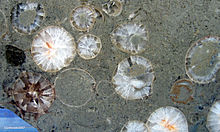Bag emitter
| Bag emitter | ||||||||||||
|---|---|---|---|---|---|---|---|---|---|---|---|---|

Cystoids from Ernst Haeckel's Art Forms of Nature . Complete specimens in the center, isolated calyx capsules (counters) on the right and left. One edrioasteroid , which does not belong to the cystoids, is located on the lower right and lower left . |
||||||||||||
| Temporal occurrence | ||||||||||||
| Upper Cambrian to Upper Devonian | ||||||||||||
| 500 to 360 million years | ||||||||||||
| Locations | ||||||||||||
|
||||||||||||
| Systematics | ||||||||||||
|
||||||||||||
| Scientific name | ||||||||||||
| Cystoid | ||||||||||||
| from book , 1846 |
The pouches (Cystoidea) are an extinct class within the tribe of the echinoderms (Echinodermata) and are distantly related to the sea lilies and hair stars (class Crinoidea , sub-tribe Crinozoa) still living today . In the systematics, the bag emitters with about 100 genera are summarized in the sub-strain Blastozoa together with the other extinct classes Eocrinoidea , Blastoidea (bud emitters), Paracrinoidea and Parablastoidea .
The bag emitters are probably a polyphyletic group that emerged from the Eocrinoidea in the Upper Cambrian . They had the greatest variety of forms in the Ordovician . In the Silurian and Devonian they lose more and more of their importance, the last species disappears in the Upper Devonian .
Typical of the bag emitters is a pore system, presumably used for breathing, which was either arranged in pairs (Diploporitida) or consisted of pore rhombuses (Rhombifera). Accordingly, the cystoids can also be subdivided into the classes Rhombifera and Diploporita in the system.
During the middle Ordovician, the genus Echinosphaerites occurs in such abundance in the Baltic Sea region that it became rock-forming ("crystal apples").
Way of life
The bag emitters nourished themselves by filtering edible particles with their brachioles from the flowing water and feeding them to their mouths via feed channels.
Some bag emitters were permanently attached to the seabed with a stick ( sessile ), others could possibly loop their stem around a suitable object and would have even been able to change their location ( vagile ). Other forms did not have such an extension and stuck to the ground or stuck in the sediment.
literature
- Bernhard Ziegler: Introduction to Paleobiology Part 3 . ISBN 3-510-65179-0
- Treatise of Invertebrate Paleontology: Part S Echinodermata 1 . ISBN 0-8137-3020-1
Web links
- The Paleobiology Database Cystoidea
